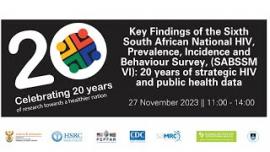
KwaZulu-Natal has recorded the second-highest HIV prevalence rate at 16% in 2022, down from 18% in 2017.
According to the Human Sciences Research Council (HSRC), this translates to 1 980 000 people living with HIV (PLHIV) in KwaZulu-Natal, which was a decline from 1 990 000 in 2017.
The information is based on the findings of the Sixth South African HIV Prevalence, Incidence and Behaviour Survey (SABSSM VI).
SAnews reported last week that Mpumalanga now has the highest HIV prevalence at 17.4% in 2022, which translates to an estimated 890 000 (PLHIV) in the province.
READ | Mpumalanga records highest HIV prevalence rate
According to the overall principal investigator of the study, the HSRC’s Professor Khangelani Zuma, the survey showed that in 2022, HIV prevalence in the province was higher among those aged 25 to 49 (31.1%), for both females (38.4%) and males (21.5%).
HIV prevalence was also higher among those residing in rural formal or farm areas (20%).
“HIV prevalence peaked at 44.5% among those aged 45 to 49 in 2022 from 39.7% in 2017 among those aged 35 to 39, indicating a possibility of continuing infections among older people. HIV prevalence had decreased by 2022 among all age groups younger than 40 years compared to 2017,” Zuma said.
By district, in 2022, HIV prevalence was highest in uMgungundlovu (19.5%).
The data presented are for eight priority districts within KwaZulu-Natal namely, eThekwini, Harry Gwala, King Cetshwayo, Ugu, uMgungundlovu, uThukela, Zululand and uMkhanyakude districts, as per the study protocol.
Antiretroviral treatment
Antiretroviral treatment (ART) coverage in KwaZulu-Natal increased to 87.3% in 2022, from 71.2% in 2017.
The ART coverage estimate translates to an estimated 1 609 000 PLHIV in the province receiving treatment in 2022.
In 2022, ART use among all PLHIV in the province was lowest among adolescents and youth aged 15 to 24 (62.8%) compared to other age groups.
ART use was also lower among both males (58.8%) and females (64%) in this age group compared to other age groups.
Among children aged zero to 14, ART use among males was 83.5% compared to females (65.9%). Among rural formal areas, ART use among males (93.3%) was comparable to females (93.6%).
The SABSSM VI survey, conducted between 2022 and 2023, aimed to maintain surveillance of HIV infection and behaviours in South Africa, evaluate the progress of the South African national HIV and AIDS, STI and TB Strategic Plan, and monitor HIV indicators for national and international reporting.
Viral load suppression
On the viral load suppression, the survey further revealed that, in 2022, among all provinces, KwaZulu-Natal had the highest proportion of all PLHIV with VLS (86.8%), having increased from 2017 (67.8%).
Knowledge of HIV status
The professor expressed concern that those aged between 25 and 49 accounted for the majority of PLHIV in the province (68.3%) who were unaware of their HIV status (54.5%), aware but not on ART (63.5%), and on ART but not virally suppressed (66.4%).
“However, adolescents and youth aged 15 to 24 contribute disproportionally to gaps in treatment, accounting for just 8.5% of all PLHIV, but 28.4% of those unaware of their HIV status, 19.1% of those aware but not on ART and 15.7% of those on ART but not virally suppressed.”
Sex debut
Regarding the key drivers of the HIV pandemic, Zuma noted that, in KwaZulu-Natal, there was no change in the proportion of adolescents and youth aged 15 to 24 who reported having sex before the age of 15 in 2017 (8.2%) compared to 2022 (8.6%).
However, sexual debut before the age of 15 among adolescents and youth between 15 and 24 years in 2022 was higher among males (12.3%) than females (4.8%).
The survey revealed that 11% of people aged 15 and older reported having multiple sexual partners in 2022 compared to 9.4% in 2017.
The proportion of people aged 15 and older who reported having multiple sexual partners was five-fold higher among males (18.6%), compared to females (3.5%), and 1.5-fold higher among those aged 15 to 24 (16.3%) compared to those aged 25 to 49 (10.9%).
The proportion of people who reported having multiple sexual partners was highest in Harry Gwala (14.1%) and lowest in uThukela (7.6%).
Condom use
Regarding condom use, the survey revealed that 32.8% reported using a condom with the most recent sexual partner in 2022 compared to 44.9% in 2017, representing a 12.1% decline.
In KwaZulu-Natal, a higher proportion also reported that they never (45.2%) used a condom with their most recent sexual partner.
“Only 9.3% reported that they used condoms almost every time.”
Meanwhile, consistency of condom uses with the most recent sexual partner among people aged 15 and older in the province was higher among adolescents and youth aged 15 to 24 (26.7%) compared to those aged 25 to 49 (16.5%).
“However, nearly 60% of youth reported only using a condom sometimes or never.”
Zuma recommended a long-term strategy to care for people in an ageing HIV epidemic as well as tailored interventions to address gaps in the “clinical cascade”.
“We also recommend a continued focus on increasing coverage and demand for medical male circumcision among males aged 15 and older. We must also enhance public awareness and uptake of effective HIV prevention measures, such as regular HIV testing, condoms and PrEP [pre-exposure prophylaxis],” Zuma added. – SAnews.gov.za


